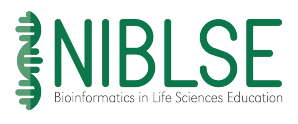Meeting Summary
A group of 50 NIBLSE members gathered for the 3rd NIBLSE Conference. The weather was delightful for the first day then turned downright cold for the second day. Even so, unlike the previous NIBLSE meeting in Omaha, there was no tornado. The meeting was held in an artist community called Hot Shops, which was an interesting venue that was enjoyed by all. In the spirit of the surroundings, NIBLSE members competed in an art contest (results displayed to the right). The honorary NIBLSE art judge (Angela) awarded the blue ribbon to Jason Williams.
Day One - Welcome Reception and Poster Session
The meeting kicked off with reception and poster session. The theme of the poster session was Implementation, Assessment and Sustainability. Read NIBLSE poster abstracts.
Day Two - Conference Sessions
The day began with a brief history of NIBLSE, and a review of the Network's four key objectives by Mark Pauley and Bill Tapprich. Bill Morgan and members of the Resource Review Committee presented the Resource Collection, Learning Resource Incubators and innovations in the QUBES Open Educational Resource interface. Anne Rosenwald and members of the Barriers manuscript team presented the results of analyzing barriers to integration. During the meeting it was learned that the Barriers manuscript was accepted for publication in PLOS ONE. The Barriers paper is now published. Adam Kleinschmit and members of the NIBLSE Faculty Mentoring Network (FMN) presented the effectiveness of implementing learning resources using the FMN model. Rochelle Tractenberg, Neal Grandgenett, Jennifer Drew and members of the Assessment and Validation Committee presented best practices for developing assessments in emerging disciplines. Two plenary sessions, one by Kathryn Miller from the PULSE Network and one by Mary Pat Wenderoth from the SABER Network provided exemplars of sustainable networks in life science education. Day two activities wrapped up with organizing a manuscript committee, led by Eric Triplett, to write a meeting report for CBE-LSE.
Day Three - Small Group Sustainability Idea Generation Workshop
Participants formed small groups to discuss and present ideas for immediate and long-term steps for sustaining the Network. The following questions were addressed:
- What is the focus and scope of NIBLSE going forward?
- What are the next steps for securing funding/resources?
- Who do we need to partner with in the short, medium, and long term?
- How do we address faculty barriers?
- How do we address student barriers?
- How do we build community and broaden participation and inclusion?
- What is the next direction for NIBLSE and assessment?
Read Conference Meeting Notes

Overall Meeting Results - Elements of the Roadmap
- Develop, engage and expand the NIBLSE community
- Enhance communication links and frequency
- Solicit and encourage submission of learning resources
- Recruit members for incubators
- Expand implementation through Faculty Mentoring Networks (FMN)
- Select learning resource for FMN
- Develop adaptations during FMN
- Scaffold implementation by having FMN participants lead an FMN
- Explore underlying causes for barriers
- Seek supplemental funding to conduct targeted interviews about barriers
- Design follow up survey
- Select or design learning resources that address fundamental biology concepts
- Enable biology faculty to teach concepts using bioinformatics
- Explore linking bioinformatics learning resources to OER textbook
- Vertically integrate vetted learning resources for widespread implementation
- Evaluate most effective design for future conferences
- Perhaps designate existing society meeting for NIBLSE meeting
- Perhaps regionalize meetings to enable accessibility to students
- Perhaps formalize membership and organize annual NIBLSE conference
- Organize IUSE Proposal (Transforming the Community) for December 2020 submission
